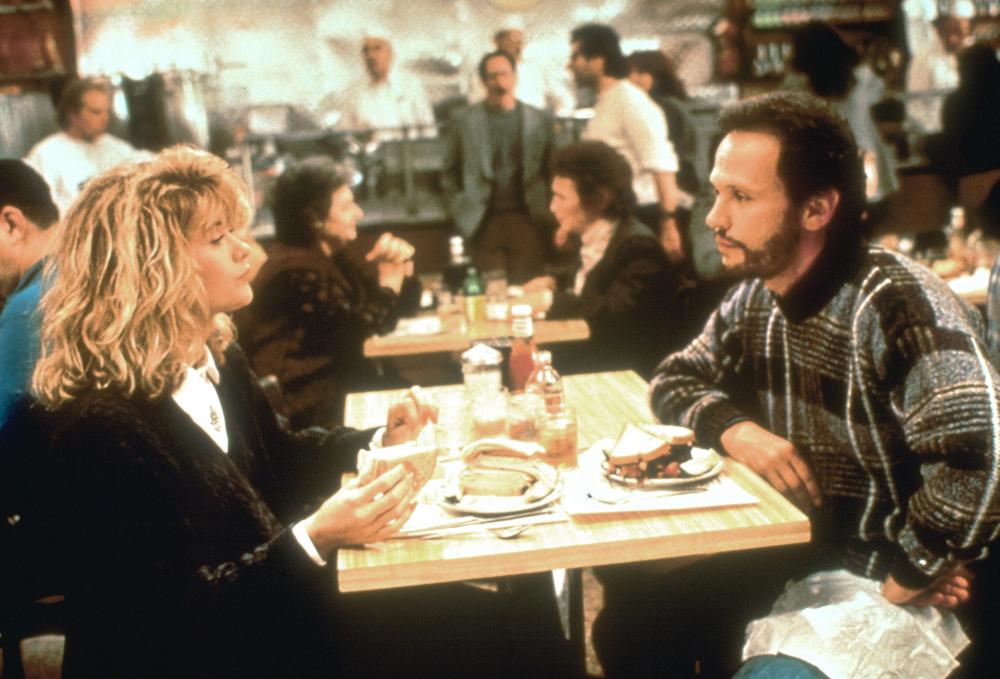
“I’ll have what she’s having.”
From the moment Rob Reiner’s mother first uttered the line onscreen 25 years ago, it was destined to become the most memorable moment in When Harry Met Sally…. But while the line — not to mention the equally famous “fake orgasm” bit it serves as a punchline to — is hilarious, it’s far from the most special thing about the film. Two and a half decades later, it’s still the quintessential romantic comedy.
Directed by Rob Reiner, and starring Meg Ryan and Billy Crystal, the film resonated with audiences immediately when it was released on July 14, 1989. Famously exploring whether men and women can ever be just friends — or whether sex will get in the way — the movie follows Harry Burns, an easy-going pessimist, and Sally Albright, a finicky optimist, over the course of twelve years. While the pair get off to a rocky start, they eventually become friends and then, something more. Of course, the will-they-won’t-they tension wasn’t a revolution to the rom-com genre, but the wit and charm that infused the dialogue, and the charisma that both Ryan and Crystal brought to the screen, struck a chord with romance lovers everywhere.
The film became a box office hit, raking in more than $90 million in the U.S., and was generally well-received by reviewers. But a few critics seemed disgruntled by the movie’s obvious nods to Woody Allen films like Annie Hall and Manhattan. In its review, the New York Times called the movie a “Woody Allen wannabe,” citing the opening credits with “white letters on a black background,” scenes that are “infatuated with Manhattan” and “dialogue obsessed with love, sex and death.” While it’s true that there are plenty of Woody Allen nods in the film, it’s also true that When Harry Met Sally… is far sunnier and more sentimental — in a good way — than the average Allen pic.
Today it almost seems odd to think of the movie — now iconic in the rom-com genre — as a “Woody Allen wannabe,” especially since so many films made since are clearly When Harry Met Sally… wannabes. Countless romantic comedies made in the ‘90s and 2000s blatantly tried to capture the charm of Harry and Sally, some with great results (like, say, My Best Friend’s Wedding) and others less so (A Lot Like Love, we’re looking at you). Even sitcoms like Seinfeld and The Mindy Project have incorporated nods, both subtle and blatant, to the film. Despite the imitators and the years and the changes in the rom-com genre, When Harry Met Sally still sticks out from the pack.
Part of what makes the movie so great is its simplicity. First of all, the two leads aren’t thrown together due to some ridiculous bet (How to Lose a Guy in 10 Days, She’s All That), nor are they dealing with any kind of magic or spell (Groundhog Day, 13 Going on 30). Harry and Sally aren’t even grappling with any class or status differences (Pretty Woman, Notting Hill). Both are white and privileged, living in New York with huge apartments and loads of disposable income and time.
Instead, the Harry and Sally are simply dealing with the age-old question of the differences between men and women. The issues that the pair — along with their two best friends, Jess and Marie, excellently played by Bruno Kirby and Carrie Fisher, respectively — face are pretty universal in the relationships of 20 and 30-somethings everywhere: fights over possessions when moving in with someone; needing a “transitional person,” aka a rebound, after a break-up; dealing with a partner who’s “high maintenance” — a term that the movie just happened to have coined. And, of course, the tension and awkwardness that follows having sex with a good friend. What’s even more remarkable is how relevant the movie still feels today. Watch it again. Aside from some hairstyles and sartorial choices, the film has aged remarkably well, largely thanks to its script.
Of course, it would be a crime to discuss When Harry Met Sally… without mentioning its script, and its script-writer, the late, great Nora Ephron. Throughout her impressive career as a journalist, essayist, screenwriter and director, Ephron’s wit and sharp observations about human nature always shone through — and there’s nowhere that’s more apparent than in When Harry Met Sally…. Though “I’ll have what she’s having” is by far the most quoted line from the film — a Billy Crystal contribution, it should be noted — Ephron’s script is packed with lines that are gems. There are so many great lines that it’s difficult to pick out the best moments; from the funny (“Thin. Pretty. Big tits. Your basic nightmare”) to the poignant (“You know what I miss? I miss the idea of him”) to the absurd (“You made a woman meow?”), each line is sharp and witty and true. It’s no wonder that Ephron was nominated for an Oscar for her script.
But maybe above all else, the movie stands out because it’s romantic. Though their romance is a slow burn, Harry does finally make a grand declaration of love to Sally, saying, “I came here tonight because when you realize you want to spend the rest of your life with somebody, you want the rest of your life to start as soon as possible.” It’s enough to make even the most hardened skeptic melt — and thank the rom-com gods for introducing them to When Harry Met Sally….
More Must-Reads from TIME
- Donald Trump Is TIME's 2024 Person of the Year
- Why We Chose Trump as Person of the Year
- Is Intermittent Fasting Good or Bad for You?
- The 100 Must-Read Books of 2024
- The 20 Best Christmas TV Episodes
- Column: If Optimism Feels Ridiculous Now, Try Hope
- The Future of Climate Action Is Trade Policy
- Merle Bombardieri Is Helping People Make the Baby Decision
Contact us at letters@time.com